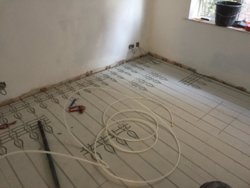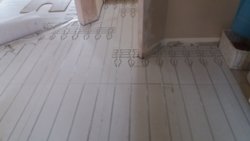Very interesting thread...
The Hetta system is a popular one which many suppliers of UFH sell, however any type of EPS or XPS Polystyrene boards need a overboard before any form of tile can be applied to it. These systems are really suited for a Engineered Wood or Laminate. You can use a screed board over the top of it which is then fixed to the sub base however you have to be very careful of the pipes and where you're placing the screws.
These very reasons are why there's a new type of product on the market which is the Gypsum Retrofit panels which are a solid gypsum board which can accept a tile directly laid on top. The Gypsum boards have certainly become more popular recently due to not needing any extra materials. We supply a 18mm Version of this panel with pre-grooved pipe channels and end returns built in, suitable for a 12mm PERT Pipe. These boards can be primmed on the face and base before any adhesive or leveller is applied.
With our boards we state that the unused pipe channels need to be filled with compound before either a decoupling or tile is laid, this removes any voids that could be under the floor. I've attached a few photos from customers installations. If anyone needs any help on a system or installation, give me a call or send me a PM as we're happy to help everytime!



The Hetta system is a popular one which many suppliers of UFH sell, however any type of EPS or XPS Polystyrene boards need a overboard before any form of tile can be applied to it. These systems are really suited for a Engineered Wood or Laminate. You can use a screed board over the top of it which is then fixed to the sub base however you have to be very careful of the pipes and where you're placing the screws.
These very reasons are why there's a new type of product on the market which is the Gypsum Retrofit panels which are a solid gypsum board which can accept a tile directly laid on top. The Gypsum boards have certainly become more popular recently due to not needing any extra materials. We supply a 18mm Version of this panel with pre-grooved pipe channels and end returns built in, suitable for a 12mm PERT Pipe. These boards can be primmed on the face and base before any adhesive or leveller is applied.
With our boards we state that the unused pipe channels need to be filled with compound before either a decoupling or tile is laid, this removes any voids that could be under the floor. I've attached a few photos from customers installations. If anyone needs any help on a system or installation, give me a call or send me a PM as we're happy to help everytime!



